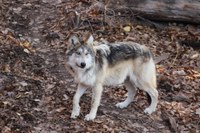Dec. 10, 2019 - This year, the ABQ BioPark continued its legacy to support the endangered Mexican gray wolf by welcoming baby lobos to the pack, rehabilitating wild wolves and caring for wolves behind the scenes while they wait for their next destination.
In May, wolves Kawi and Ryder welcomed three baby lobos after being paired together in December. The surviving male pup, Archer, is thriving and now nearly indistinguishable from the adults.
"He's getting more curious and more confident in the pack," said Lynn Tupa, ABQ BioPark Zoo manager. This means he's exploring more of the exhibit independently. ABQ BioPark staff hope that he will help raise any future litters that his parents produce.
The
May birth marked the first time in nearly 15 years that the ABQ BioPark welcomed Mexican wolf cubs. To date, the Zoo has had 72 wolf cubs born, although not all wolf pups survive: approximately 30 percent of all Mexican wolf pups pass away by their first birthday.
In addition to the birth, the ABQ BioPark continues to serve as an important holding facility for the species. That means some wolves stay behind the scenes and are cared for by staff while they await their next destination. The Zoo received a female wolf in November and a male wolf in December, who will be companions while they wait for a permanent pairing at another facility.
"Because we're kind of the hub, we get wolves from everywhere," said Tupa. She said the BioPark is a good fit because it's centrally located, has nice holding facilities and provides premiere wolf care.
The ABQ BioPark also temporarily holds and cares for injured wild wolves who need medical treatment and/or rehabilitation. Such was the case for two wolves received by the Zoo this November. The two came from separate wild packs in Arizona and New Mexico and had both fallen victim to leg hold traps. Both are expected to return to their wild packs after a little more care and rehabilitation from BioPark staff.
The Mexican gray wolf is a sub-species of the gray wolf. They once roamed New Mexico, Texas, Arizona and Mexico, but disappeared from the wild by the 1970s. In response, the US Fish and Wildlife Service (USFWS) launched a reintroduction program that included captive breeding. Today, they remain listed as endangered by USFWS.
Media: Photos of Kawi, Ryder and Archer can be downloaded here:

